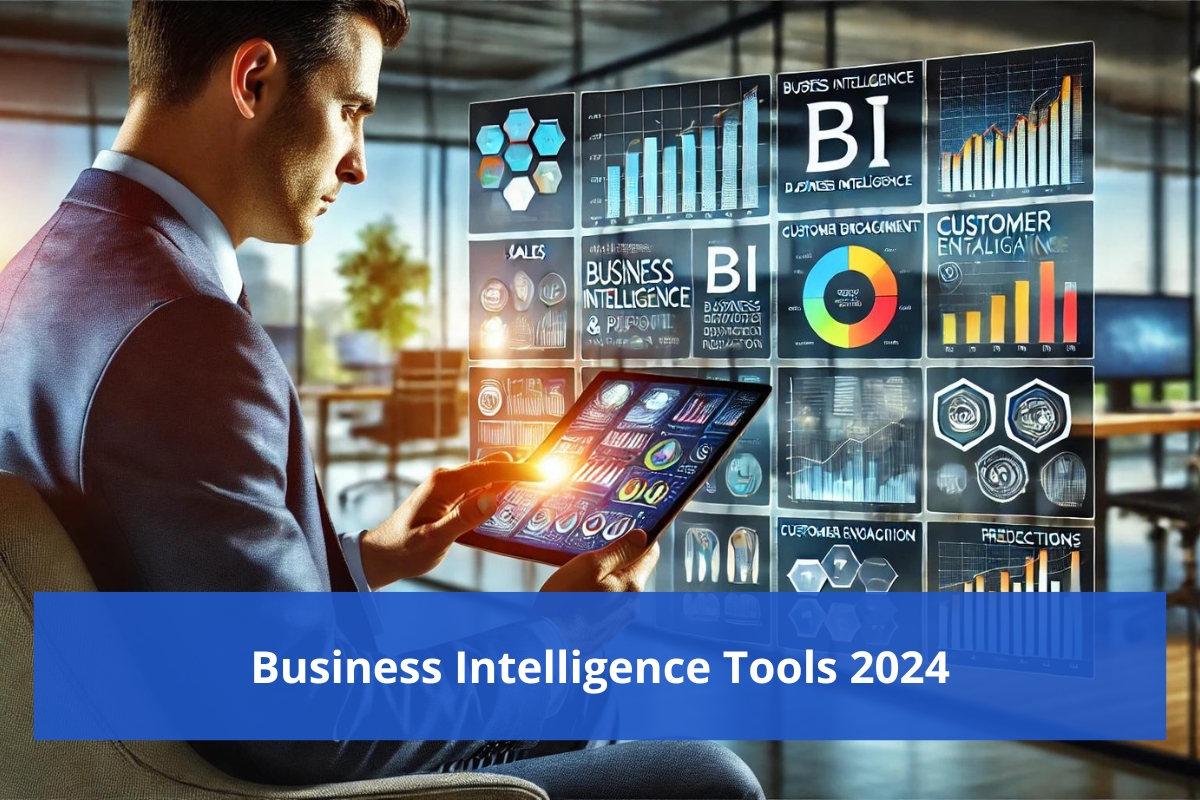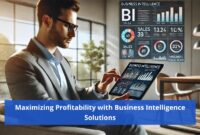Being a part of the modern business world, the effectiveness of making decisions based on statistical information is longer in dispute. The sights of organizations are being improved with new sources of data creation and accumulation, however, in order to harness this data, there are integral tools to help synthesize and evaluate this data. In this domain, we have Business Intelligence (BI) tools. BI tools are software applications that help businesses analyze large amounts of data and make good business decisions based on them.
As we approach the year 2024, the trend is positively remains even as the advancements in the artificial intelligence, machine learning and cloud technologies further extend what the BI tools can do. In this piece of writing we shall seek to explain some of the best business intelligence tools 2024, their features, benefits, and how they make businesses succeed in a data-centric world.
What are Business Intelligence tools?
Business Intelligence (BI) tools are software programs that perform a series of functions including the collection, processing and analysis of a huge quantity of data for the purpose of helping the organization make well-informed decisions. With the help of these tools, various organizations are able to collect data from different channels; databases, table excels, cloud and analyze the data and make sense out of it through reports, dashboards, charts and topologies.
Throughout every industry BI tools find use for tracking performance, spotting trends, making predictions, and improving efficiency among many others. More importantly, these analytics help in converting the available data in different ways so that businesses can enhance their growth and efficiency as well as customer satisfaction.
Why Use Business Intelligence Tools in 2024?
In 2024, most businesses would want to have an edge over their competitors considering the world is becoming more and more data-centric. Among the many uses that these BI tools offer to businesses of all sizes are the following:
Data-Driven Decision Making: BI tools allow organizations to make decisions based on actual information and insights rather than hunches and assumptions. This results in better and more accurate decisions.
Real-Time Data Access: The current BI tools enable various organizations to retrieve data in minutes, if not seconds, thus making it easy to react to changing market or internal operational conditions.
Improved Operational Efficiency: If there are shortcomings and inefficiencies in the processes that BI tools identify, they can help improve or eliminate these processes in order to optimize performance in the organization.
Enhanced Data Visualization: BI tools are equipped with advanced features for managing data and providing respective images to users so that they can understand the data and recognize patterns and trends at the back of their minds.
Predictive Analytics: Most business intelligence tools feature integration of artificial intelligence and machine learning for predictive analytic functions, facilitating accurate projections of many aspects such as trends, demand, and results in businesses deftly.
Top Business Intelligence Tools for 2024
It’s possible to keep a check on what business intelligence developments to look for in the year 2024 and some of the most recognised tools of commerce available in the market today.
Microsoft Power BI
Overview: Microsoft Power BI retains its position as the top BI tool by virtue of its market appeal as of the year 2024. Its ease of use, as well as interoperability with Office applications like Excel, Azure and Teams makes it relevant for majority of businesses regardless of their size.
Key Features
- Drag-and-Drop Interface: It is an interface devoid of complexity and enables users to create specific reports and dashboards.
- AI-Powered Insights: It is possible to embed activities that are powered by AI using the current integrated features of the BI tool
- Data Integration: Able to integrate to dozens of external applications, including clouds, data and spreadsheets.
- Real-Time Analytics: Offers data monitoring, alerts and other functionalities in real time.
- Custom Visualizations: It is possible to design visualizations and reports in many forms.
Why Power BI is Recommended for Customers?: Power BI meets the expectations of those organizations where Microsoft and its products are already deployed and further integration with them is required. Thanks to its efficient visualization capabilities and pretty user-friendly interface, it is suitable for novice as well as professionally working people handling data.
Tableau
Overview: Tableau is one of the front runners in the BI domain particularly in the area of visualization and analytics. It helps users in the analysis and presentation of data in a very simple and attractive manner.
Key Features
- Visual Analytics: Interactivity with data with the help of visualizations is a strong point of Tableau software.
- Data Connectivity: Appears to have an ability to pull data from a variety of sources including SQL databases, cloud storage and even spreadsheets.
- AI-Powered Insights: Incorporate readily available AI features such as the ‘Ask Data’ in Tableau which allows users to ask questions about the data in natural language.
- Collaboration Tools: Users of the system are able to publish the dashboards they have created to other users and work on them in real time mess free.
- Advanced Mapping Capabilities: Companies that deal with location centered marketing are able to analyze data that is geographically oriented.
Why Choose Tableau?: Tableau is perfect for organizations that need powerful data visualization tools and advanced analytics. Its intuitive interface and strong community support make it a top choice for data analysts.
Qlik Sense
Overview: A self-service business intelligence system Qlik Sense is a cloud-based software solution that helps to create interactive reports, Share and modify reports as well as visualize reports created based on associative data models which allows users to probe and analyze data from different perspectives with no need to follow query models that have been set in advance.
Key Features
- Associative Engine: Qlik’s associative engine enables users to explore data freely, identifying connections and relationships that might be missed in traditional query-based tools.
- Self-Service Analytics: Designed for both technical and non-technical users to explore data and create reports independently.
- AI Integration: Qlik’s AI capabilities help users uncover hidden insights and suggest visualizations.
- Multi-Cloud Architecture: Offers flexibility in deploying across cloud environments, including private, public, and hybrid clouds.
- Real-Time Data Processing: Allows businesses to analyze data as it is generated, providing real-time insights.
Why Choose Qlik Sense?: Qlik Sense is ideal for organizations that need a flexible, self-service BI tool with powerful data discovery features. Its associative model enables more in-depth exploration of complex data relationships.
Looker
Overview: Looker is a powerful tool that integrates with the services of the Google Cloud including BigQuery and this very efficiently facilitates the management of data.
Key Features
- Customizable Dashboards: Provides the users with the ability to design very specific dashboards or reports.
- Embedded Analytics: This is the capability of integrating analytics into applications, websites, and business processes.
What Other Reasons You Should Select Looker?: Looker provides tremendous support to organizations that operate on Google Cloud environment emphasize investing in real time analytic tools that has highly developed data governance.
Sisense
Overview: Sisense is a unique business intelligence (BI) platform that enables companies to integrate analytic capabilities into their operational processes. Its aim is to eliminate the difficulties faced in data analysis by devising a simple and effective system that is also expandable.
Key Features
- Embedded Analytics: Sisense makes it possible for companies to incorporate analytics into customer facing applications and internal processes as well.
- Data Unification: Data from various origins can be combined including those situated in the cloud, on site, and combined environments.
- AI-Powered Analytics: Sisense provides tools that utilize artificial intelligence to assist users in finding the answers or preparing the information.
- Scalability: Made for the rapid inclusion for large volumes of data, appropriate for organizations operating on vast volumes of data straightforwardly.
- Customizable Dashboards: Comprises of real time dashboards and reporting provisions which are extensive and allow for much customization.
Why Choose Sisense? Sisense is perfect for organizations that would like to add analytics to their existing applications and workflows. It is also suitable for organizations with Big Data through its data unification and scalability features.
Domo
Overview: Domo is a BI platform delivered via the cloud and provides data and process management tools in real time. It is popular because of its simple use and an emphasis of most non-technical people being able to explore and distribute data.
Key Features
- Cloud-Native architecture: Entirely Cloud-Based, hence very scalable and flexible.
- Business Automation: Domo permits organizations to perform specific workflows and processes based on the data triggers bu set up.
- Real-Time Dash Boards: This service includes the creation of dash boards that show information in real time with the use of interactive dash boards that are easily adjustable and even shared. B2B even.
- Mobile BI: The mobile application availed by the Domo overcomes these challenges as it permits users to browse through reports and findings thus analysis can be done from any place, therefore data will be in hand when needed.
- Data Integration: Integrates with 1000+ data sources thus enabling the performance towards data analysis and integration.
Why Choose Domo?: Domo would be ideal for organizations that require a real-time BI platform as well as workflow and business process automation and is cloud-based. Further, in its design, the platform supports mobile usage making it ideal for working teams and those on travel.
IBM Cognos Analytics
Overview: IBM Cognos Analytics is a very complete BI tool offering data analysis, visualization, and reporting through AI. It is focused on big companies that require large analytics in relation to varied data sets.
Key Features
- Insights: Cognos’ AI enables the software to find and give insights or detect insights automatically.
- Natural Language Processing (NLP): The users are able to use natural language to ask questions and get insights from the data without having to learn the different query languages.
- Cognos Data Discovery: Cognos comes with a fully interactive and visually grabbing data exploration tools.
- Complex Reporting: Enables reporting features with high levels of customisation for large enterprises with intricate data requirements.
- Team Optimization: Optimizes the use of the reports where team members can work on reports and insights easily.
Why Choose IBM Cognos Analytics?: The IBM Cognos is most appropriate for large organizations in search of advanced business intelligence system which is integrated with the use of AI systems to render insights in reporting.
Conclusion
The Business Intelligence technologies in 2024 has a lot to offer in the form of useful tools aimed at ensuring businesses make the most of their data. These tools include real time analytics, AI-driven insights, dashboards which can be customized easily and integrated into the cloud, and are all necessary to promote the making of informed decisions supported by data and efficiency in operations.
Whether you’re a small business looking for an intuitive, user-friendly solution or a large enterprise in need of advanced analytics, there’s a BI tool in 2024 that can meet your needs. By selecting the right tool, businesses can stay competitive, streamline their operations, and unlock valuable insights that fuel growth.



